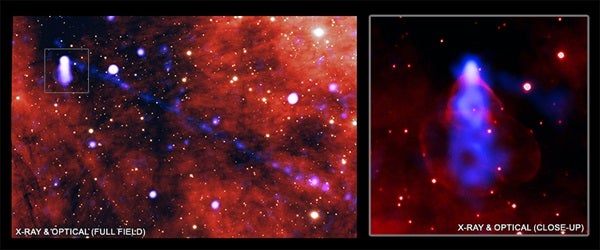Antimatter isn’t just science fiction. These particles are like ordinary matter, but with opposite charges. A positron, for instance, is an antielectron. A positron has the same spin and mass as a negatively charged electron, but it has a positive charge.
One curious feature about antimatter particles is that when they comes into contact with particles of regular matter, they annihilate each other, releasing all their mass as energy. Most of the universe consists of matter particles, but scientists have found evidence of large swaths of positrons using Earth-based detectors. Where is all this antimatter coming from?
A new study using data from NASA’s Chandra X-ray Observatory, to be published in The Astrophysical Journal, indicates that pulsars might be one culprit for the observed excess in positrons.
Pinning it on the pulsars
Pulsars are highly magnetized, spinning neutron stars, which are the extremely dense remains of massive stars. As they spin, pulsars emit beams of light that make them appear to blink, like a lighthouse. Thanks to their incredibly fast rotation rate, these pulses can appear ever second or even millisecond.
Together, a strong magnetic field and a fast spin make for a perfect storm when it comes to creating electron and positron pairs. These particles are usually trapped within the object’s magnetic field.
In the case of PSR J2030+4415 (J2030 for short), which the Chandra study observed, the pulsar is traveling through our galaxy at about 500,000 mph (800,000 km/hr). At that speed, the winds (and particles) are trailing behind the object while a bow shock of gas leads in front of it — similar to how water piles-up in front of a boat. Somehow, however, about 20 to 30 years ago, the bow shock slowed down and J2030 caught up to and smashed into it.
The resulting collision caused a particle leak, allowing electrons and positrons to trickle out into interstellar space. The result: a beam of matter and antimatter 40 trillion miles (64 trillion kilometers) long.
“It’s amazing that a pulsar that’s only 10 miles across can create a structure so big that we can see it from thousands of light-years away,” said lead author Martijn de Vries of Stanford University in a press release. The filament spans approximately half the angular diameter of the Moon.










